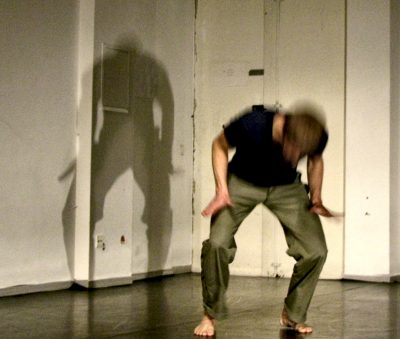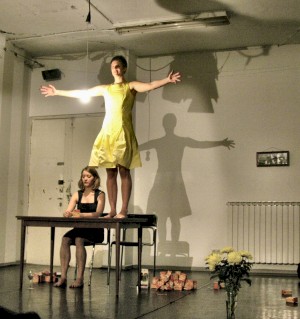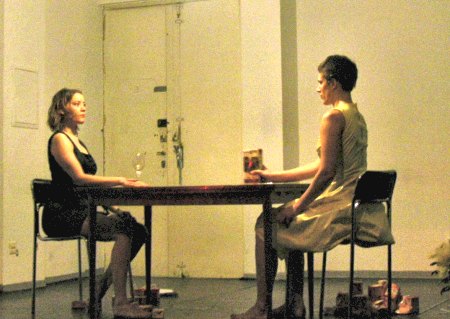NAH DRAN in ADA77: Part 1
Berlin, ada77, February 2007; text posted to tanznetz.de

Jörg Haßmann: Just a dance
I have seen a lot of weird places where contemporary off-scene thrives in Berlin. The last I learned about is ada77. The stage is a middle-sized room in an apartment house. During breaks the audience has to withdraw into a staircase, where the light goes out each three minutes turning the place completely dark until someone pushes the light button. The lack of basic facilities and a near-zero budget do not seem to suppress artistic creativity, just the opposite. If you are not bothered by sitting on uncomfortable chairs or on the floor, don't need glossy program brochures and are prepared to watch performances at various stages of maturity and professionalism, you will be enchanted by the freshness and candor of the pieces and often baffled by the inventiveness of the artists, who are "free" in more ways than one. Personally I can tolerate imperfections in the movement, technical immaturity and deficiencies in the implementation or dramaturgic concepts. It makes me furious, however, when one of the media-pampered sanctuaries presents a piece that is unbalanced, half-heartedly performed, overloaded with theatrical effects, selling entertainment as "critical reflection" and camouflaging the lack of creativity by intellectualism. With the exception of the first, you hardly ever encounter these annoyances on off-scene stages.
I did not get much out of Jörg Haßmann's beginning passage which was a kind of warming up, but the middle part was very interesting. It started as a solo for one arm, twisted and turned while the remaining body remained motionless and immobile. Invisible strings then connected the arm to the dancer's head, forcing the head to follow the movement of the arm and interact with it as if they were coupled marionettes. The second arm joined the story, the dancer walked a few steps and the imaginary strings became attached to some place of the ceiling. The movements of one arm pulled the other into the opposite direction and the story unfolded while growing in complexity. In the final part the dancer claimed most of the stage in a spectacle of speed and power, slowing down only in a hip-hop interlude.
Eva Burghardt, Nina Wehnert: Finish tango
(Text posted to tanznetz.de)


Burghardt's and Wehnert's "Finish tango" was premiered last year and has become popular in Berlin already. The title refers to the last part of the performance, in which a wine glass and a box of orange juice dance tango as they are shifted on a table in jerky movements. What makes the piece so humorous is not just the simulation of the sensual rhythm by silly utensils, but also the parody of the pathos associated with tango. Look at Eva Bughardt (left on the right photo): Sitting upright in her chair, she gazes into the eyes of her partner while resolutely moving her glass forth and back. Fatal desire is at the heart of the tango stereotype and a stony face is a must. Flamenco, by the way, relies on the same stereotype: any smile would expose its inflated pathos as pretence. This is why both tango and flamenco find their way into modern performances only as a parody. They are rare examples of terminal branches in the phylogeny of dance, dead-ends in the quest for the expression of emotions by body movement and music.
The tango parody made the piece famous, but it is just its last part. "Finish tango" starts with Burghardt and Wehnert sitting on chairs at a table and dancing in synchronized movements of their upper bodies above and on the table. A performance with small boxes of fruit juice (I think it was "Hohes C") follows. In a synchronized fashion, each performer grasps a box, places it on the table, turns it around, takes off the drinking straw, sticks it into the box and draws a sip. During this procedure they repeat a mantra which sounds like this: "Eins zwei, eins zwei drei vier, unten oben, oben unten, weg". Used boxes are thrown aside. Unnecessarily but inevitably, a moment comes when a box with a straw sticking in it is used to sprinkle juice on the performer's dress in a slapstick manner. The speed increases and the performance culminates in a triumphal scene, accompanied by Black Eyes Peas's music. Nina Wehnert climbs onto the table and Eva Burghardt holds a handwritten panel "Art is beautiful".
The second piece of the evening, danced by Daniela Lehmann, will get an extra page.
Petr Karlovsky